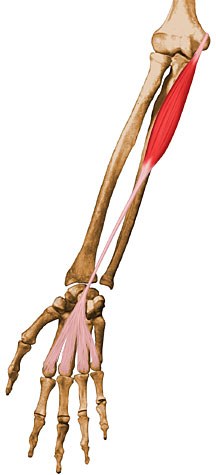Palmaris Longus: Difference between revisions
Mudra Shah (talk | contribs) No edit summary |
Mudra Shah (talk | contribs) No edit summary |
||
| Line 31: | Line 31: | ||
== Tests to determine the presence/absence of the muscle == | == Tests to determine the presence/absence of the muscle == | ||
Over the years, several clinical tests have been developed by practitioners from around the world to accurately detect the Palmaris Longus muscle. These tests merely rely upon certain positions of the wrist and hand in order to put the muscle in a state of tension so that it's tendon is both visible and palpable. The validity and reliability of the tests, however, show variations amongst each other<ref name=":2">Kigera JW, Mukwaya S. [[Clinical Assessment of the Palmaris Longus–Accuracy of common tests]]. Annals of African Surgery. 2012;9(2).</ref>. | Over the years, several clinical tests have been developed by practitioners from around the world to accurately detect the Palmaris Longus muscle. These tests merely rely upon certain positions of the wrist and hand in order to put the muscle in a state of tension so that it's tendon is both visible and palpable. The validity and reliability of the tests, however, show variations amongst each other<ref name=":2">Kigera JW, Mukwaya S. [[Clinical Assessment of the Palmaris Longus–Accuracy of common tests]]. Annals of African Surgery. 2012;9(2).</ref>. | ||
==== 1. Schaeffer's Test<ref name=":2" /> ==== | ==== 1. Schaeffer's Test<ref name=":2" /> ==== | ||
* The first test developed in 1909 | * The first test developed in 1909 | ||
* Involves maintaining the forearm at 90 degrees first | * Involves maintaining the forearm at 90 degrees first followed by moving the thumb in opposition towards the little finger with the wrist partially flexed. | ||
==== 2. Mishra's Test<ref name=":2" /> ==== | ==== 2. Mishra's Test<ref name=":2" /> ==== | ||
Revision as of 19:30, 16 June 2018
Original Editor -
Top Contributors - Mudra Shah, Mandeepa Kumawat, Manisha Shrestha, Admin and Nikhil Benhur Abburi
Description[edit | edit source]

The Palmaris longus (PL) muscle is a long, slender muscle which is usually present in the volar compartment of the forearm, interposed between the flexor carpi ulnaris and the flexor carpi radialis muscles.
However, it is currently accepted as a vestigial muscle since studies have shown that almost 30% of the population could be lacking this muscle either in one forearm (unilateral) or both the forearms (bilateral) but the percentage can always vary. The peculiarity associated with this muscle is not merely its presence or absence, but it's high degree of anatomical variations even when present.
Apart from its anatomical anomalies, there are other categories of variations of the Palmaris Longus muscle in terms of its prevalence amongst different ethnicities, it's absence being more common in women and bilateral as well as the higher occurrence on the left upper limb when unilateral[2].
Anatomy[edit | edit source]
Origin[3][edit | edit source]
Medial epicondyle of the humerus via the common flexor tendon
Insertion[3][edit | edit source]
Palmar Aponeurosis and Flexor Retinaculum at the wrist joint
Nerve Supply[3][edit | edit source]
Median Nerve
Arterial supply[1][edit | edit source]
Ulnar Artery
Function[edit | edit source]
- Palmaris longus synergistically works with the long flexors of the forearm to bring about flexion at the radiocarpal joint.
- Apart from this, the muscle also helps in tightening the palmar aponeurosis.
Tests to determine the presence/absence of the muscle[edit | edit source]
Over the years, several clinical tests have been developed by practitioners from around the world to accurately detect the Palmaris Longus muscle. These tests merely rely upon certain positions of the wrist and hand in order to put the muscle in a state of tension so that it's tendon is both visible and palpable. The validity and reliability of the tests, however, show variations amongst each other[4].
1. Schaeffer's Test[4][edit | edit source]
- The first test developed in 1909
- Involves maintaining the forearm at 90 degrees first followed by moving the thumb in opposition towards the little finger with the wrist partially flexed.
2. Mishra's Test[4][edit | edit source]
- Involves passive hyperextension of the Metacarpophalangeal Joints along with mild active wrist flexion.
3. Thompson's Test[4][edit | edit source]
- Maneuver involves first making a fist with the testing hand, followed by wrist flexion against the resistance with the thumb flexed over the other digits.
4, Gangata's Test[4][edit | edit source]
- The initial testing position is the thumb in abduction. The subject is then asked to resist both thumb abduction and wrist flexion.
5. "Two Finger Sign" - Pushpakumar's Test[4][edit | edit source]
Clinical Significance[edit | edit source]
References[edit | edit source]
- ↑ 1.0 1.1 Derek Moore. Palmaris Longus. Available from: https://www.orthobullets.com/anatomy/10023/palmaris-longus [Accessed: 12 June 2018]
- ↑ Sebastin SJ, Lim AY, Wong H. Clinical assessment of absence of the palmaris longus and its association with other anatomical anomalies-a Chinese population study. Annals-academy of Medicine Singapore. 2006 Apr 1;35(4):249.
- ↑ 3.0 3.1 3.2 Snell RS. Clinical Anatomy By Regions. 9th edition. Philadelphia: Lippincott Williams & Wilkins; 2012.
- ↑ 4.0 4.1 4.2 4.3 4.4 4.5 Kigera JW, Mukwaya S. Clinical Assessment of the Palmaris Longus–Accuracy of common tests. Annals of African Surgery. 2012;9(2).






